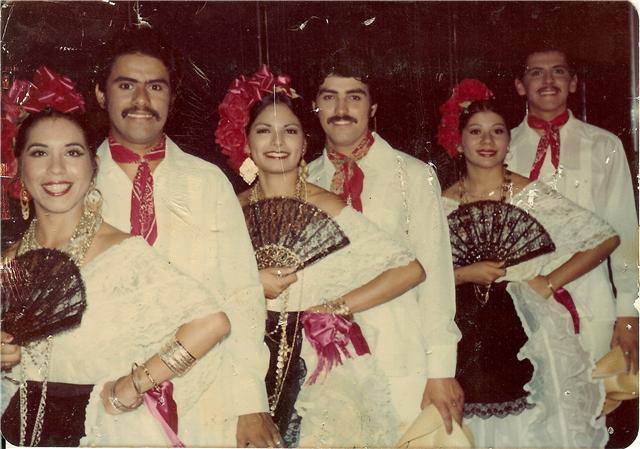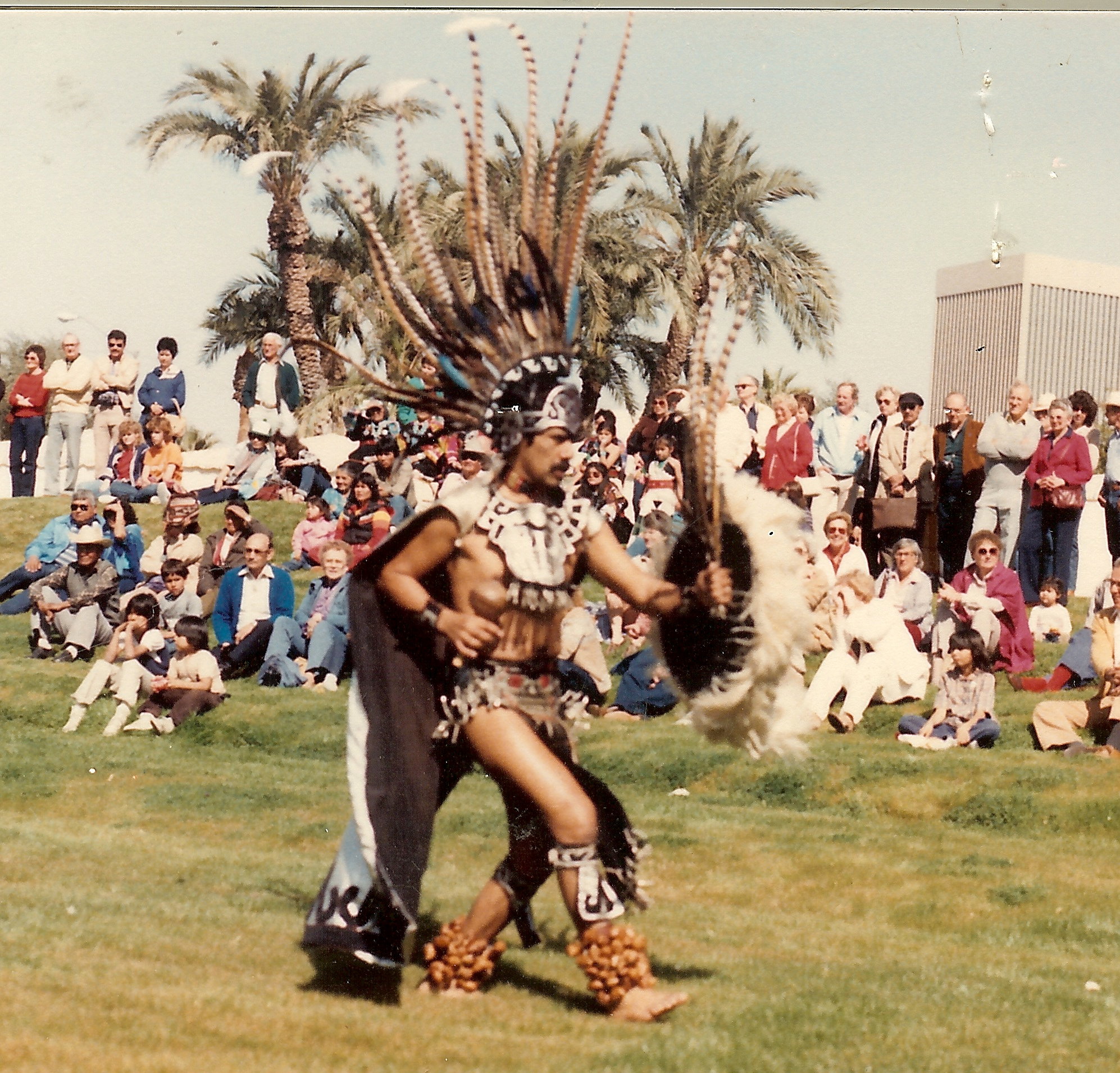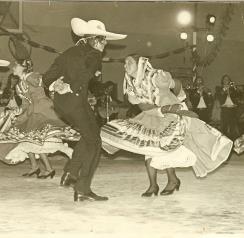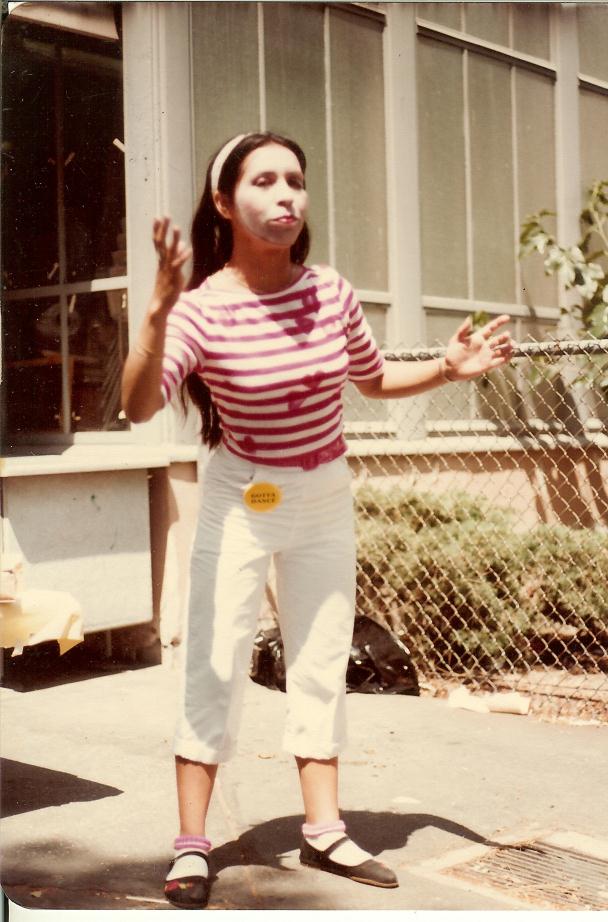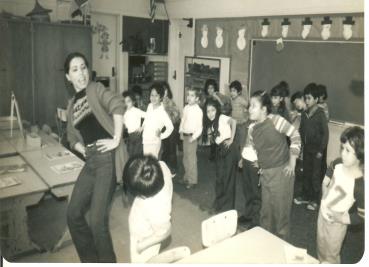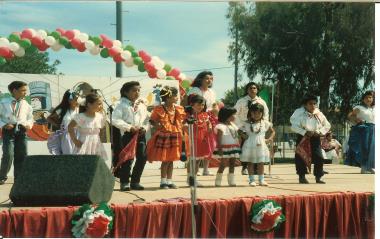
Dance History
Andy was always an energetic boy. He was always running back and forth to the Anderson Memorial Park with homemade tortillas in his back pocket. He and his brothers were always working selling newspapers to the cannery workers coming
home on the ferry at Ports of Call. His effort to participate in sports during high school was placed on a back burner because of the financial necessity to keep working to help out his mom.
While attending Cal State Long Beach, Andy and his brother Clemente realized a good way to meet girls was to join the Mexican Folklorico Class being taught by Raul Macias. He began learning the various regional dances from throughout
While attending Cal State Long Beach, Andy and his brother Clemente realized a good way to meet girls was to join the Mexican Folklorico Class being taught by Raul Macias. He began learning the various regional dances from throughout
Mexico. He then became an educational aide at his alma mater, San Pedro High School, and began a period A (7:10 - 8:00 ) Folklorico class with Ms. Friedman. The class was taught in the Girls' Gymnasium and would carry close to 50 students
each semester. His sister, Patsy, was a principal dancer in the group. This group later joined another group from Narbonne High School and performed in the yearly event hosted in the East L.A. area - Esplendor Mexicano. Andy was,also, hired
along with his friend, Manny Gonzalez, to teach foklorico at Poly High School in Long Beach.
Dance Experience / Community Involvement
Norma always loved dancing. She and her older sister, Licha, were always
putting on talent shows on their block or making up their own song & dance
routines. Her family could not afford fancy dance lessons or classes, so
dancing was pretty much whatever she could learn at any school dance,
home party or on television. Norma was chosen Best Dancer in her ninth
grade class and Most Likely to Succeed at Stephen White Junior High.
It wasn't until her college years (when the M.E.Ch.A. at Loyola Marymount
University ) began its' own folklorico dance group and hired folklorico master -
Emilio Pulido. This is when she was able to begin her dancing dream. The
M.E.Ch.A. Folklorico performed whenever and whereever they could.
After meeting Andy at a local nightclub, she was invited to dance with the
Long Beach group for a few performances. These performances gave her an
opportunity to meet with Andy more regularly. They began dancing even more
when they both joined the Communiity Folklorico Class at Harbor College.
In 1973, Harbor College began a community folklorico group which drew
talent from the surrounding area. The group was taught by Ricardo Peinado,
lead male dancer and choreographer for Graciela Tapia. Ricardo proved to be
a great influence in the lives of Norma & Andy. Ricardo trained with the Joffrey
Ballet and introduced the young chicanos to classical ballet. Not everyone in
the beginning class worked well with the rigor and discipline demanded by Mr.
Peinado. However, the class remained popular and presented yearly
performances along side of the Mariachi group directed by Mr. Carrey, a
professor at Harbor College. Norma & Andy became part of the main dancers
of the performing advanced group and continued learning with Ricardo even
after Harbor College hired another folklorico instructor.
Recognizing the talent and creativity of Mr. Peinado, Norma & Andy- along with
several other of the Harbor College dancers- continued hiring Ricardo as a private
instructor at Peck Park in San Pedro. The Adelante Mexican Dance Ensemble
was created and remained performing until Ricardo's passing on July 6th,1992.
The dance troupe opened for Willie Bobo at the Coconut Grove, performed in
the same program at Cal State L.A. with the then Los Lobos del Este & danced
with Lulu Washington at the Intercity Cultural Center. The choreography was researched based and authentic especially their Aztec Suite. Norma and Andy still carry on with the high caliber level of instruction and choreography under the company of Adelante Presentations in honor of their beloved maestro.
Around this same year, 1973, Andy had met a close friend in college, Tony Vasquez.
Tony invited Andy & Norma to an Azteca dance class at Plaza de La Raza being
taught by Florencio Yescas. Florencio Yescas had arrived in Los Angeles from
Tacuba, Mexico. He was a dancer at the Bellas Artes in Mexico City, D.F. He came
to Los Angeles and began teaching folklorico regional dance in various high schools.
His vision was to share the age-old traditional danzas at a professional level and
began Esplendor Azteca. This was before the "Mexica" concept was even conceived.
Andy and Norma danced with Florencio for over a decade and joined TonyVasquez'
group when called upon. They also supported Lazaro Arvizu's group Xipe Toltec after
Florencio's passing on in 1985. Andy was able to share the Azteca dances with the
students of L.A.U.S.D. as the main male dancer of the Los Amigos Teatro with Michael
Archuleta (www.mixtapublishing.com) which performed with the Inter Cultural Awareness
Program at various schools throughout the district. He, also, traveled to Wisconsin Dells
and spent a summer sharing the Danzas Aztecas with the Winnebego Tribe. Andy is, also,
featured in the DisneyWorld Epcot Center Mexican Pyramid ride as one of the market
place indios in the plaza scene. Many of Andy's friends were hired for this project -
Manny Gonzalez, Pablo Cabral and Mexicapan dancer Sal Lopez. This Disney job was
one of Florencio's last great projects.
Florencio recognized the dancing styles of many of his female dancers and supported
a female group, Las Flores de Aztlan, directed by Josefina Gallardo. Josefina was a
principal dancer with Esplendor Azteca. Las Flores included Andy as part of their
dance presentations which took them throughout California especially up north for
Fiesta de Colores in Sacramento, San Diego's Chicano Park anniversaries and the
local ceremonias in honor of Xilonen and Fiesta de Maiz with Calmecac and danced
original choreography with Kukulcan - a musical group founded by Ruben Luciano Alaniz
and Ralph Torres.
Dancing with Florencio and Josefina opened up one of a strong awareness in Norma & Andy regarding their indigenous roots. They both grew up in an era that degraded not only their Mexican heritage, but even worse, it portrayed the America Indians are savages and drunkards. The drumming in the Azteca danzas and the celebration of traditional ceremonias woke up strong feelings of pride in their indian spirits and both became active supporters of the Four Directions with Ernie Peters, Iron Circle with Tony Portillo & John Funmaker and Calmecac with Anna Espinoza and Dr. Soliz. Their lives followed down the red man road and even today, they are still standing strong in the indigenous circle. Norma and Andy are still dancing Azteca when called upon.
Even with all the dancing being done with the various groups, Norma and Andy
kept up dancing whenever possible whereever possible. They attended the
community folklorico dance class at East L.A. College taught by Benjamin
directed the outstanding folklorico group - Mexicapan. Several friends of Andy
from Cal State Long Beach were now performing members with Mexicapan. An
invitation was extended to Andy to join their folklorico group and around 1977.
Andy auditioned with a zapateado a cappella and was accepted into Mexicapan.
He remained with this group for a few years. He, also, assisted Bobby Navarette
( of Tierra fame ) with Veracruz dances at Cal State Dominguez.
Norma was accepted into other various dance groups throughout L.A. One was
Floricanto ( just starting up ) with Angela Moya which didn't fare well and another
was the Los Angeles Mexican Dance Company with Carola De La Rocha and.
Victor Durazno. Performing with the last group was cut short when the twins,
Rey & Reyna, were born in 1989.
Norma and Andy began their own folklorico group in the harbor area comprised of
the many high schools students from San Pedro and Narbonne. The group was called Los Esplendores. This company performed at many events in the San Pedro and Wilmington areas. This group performed choreography from Ricardo, Emilio and Florencio. Workshops were sponsored to bring other regional dances - like Nayarit, Yucatan Jaranas & Huasteco - to the harbor area.
Norma was hired on at the Conservatory of Fine Arts ( see video ) at Cal State, Los Angeles in 2002. This program was run by the Los Angeles Unified School District. Every Saturday morning, hundreds of students classified "Gifted" in music or dance would take classes to enhance their talents. Norma taught Creative Dance and Mexican Folklorico. Her daughter, Reyna, was accepted into the program and was able to accompany her mother on Saturdays. Unfortunately, the program administrators felt the rendition of "No Nos Moveran" as a dance piece to be too controversial and therefore, her contract was not renewed the following year.
She was able to work alongside of Miguel Delgado as an Azteca dancer in the play of La Virgin de Tepeyac. She, also, worked for a short while with The Elizabeth Waldo Ensemble performing various dances from the regions of Peru, Spain and Early California. This was the only opportunity Norma was able to perform in a duet along side of her mentor, Ricardo Peinado.
Teaching whatever they were able to learn was always a must for Andy & Norma and this dedication continues to this day.
They have taught classes whereever and whenever possible.
They have taught dancing at:
- Quinto Sol Academia. Long Beach
- Banning Recreation Center
- Escuela de Nuevo Canto, Long Beach
- Carriage Crest & Veterans' Park in Carson
- Peck Park,15th Street & San Pedro High in San Pedro
- Corona Elementary School in the City of Bell
- Middleton Elementary School in Huntington Park
- Meyler Elementary School in Torrance/Gateway
- Hawaiian Elementary School in Wilmington
- Narbonne High School in Harbor City
- St. Agnes Catholic Church in Los Angels
- Pepperdine College, Upward Bound Summer Program
- Cal State Dominguez, Guest Instructor
and they still keep teaching and dancing .............
Adelante Mexican Dance Ensemble
Norma & Andy, Laura Munoz, Robert Reyes,
Rose Mary Morales & Felipe Picaso
Coconut Grove October, 1977
Mexicapan - Los Voladores
East L.A. College
Jalisco, Loyola Auditorium 1975
Norma developed a strong interest during the late 1970s in breakdancing and popping because of
its' use of mime technique. She took local classes to learn various breakdance moves and taught
breakdancing and disco while at Corona Elementary. But Norma enjoyed the art of Mime that she
decided to study this technique and master it.
She studied with Judi Garratt, Los Angeles based Mime master and performer with the Performing
Tree with LAUSD. This class at East L.A. College also introduced magic and creative movement
for entertainment purposes.
Using these techniques, Norma formed Mime Time and recruited Andy as a participant. Mime Time
performed locally at various parks and as far as Self Help Graphics in East Los Angeles for parties,
community events and fundraisers.
Mime Time consisted of different mimers including Norma's niece, Kristina Mendoza. Norma has
taught mime technique to various groups and ages. It is still one of her favorite area of
performances.
Even when Andy and Norma began their family, they
continued to share their teaching and dancing with a core
group of friends with kids of their own. Over a dozen families
organized the Escuela de Nuevo Canto located at the Quinto
Sol Escuela on 7th Street in Long Beach.These families
strongly believed that their children should be educated with
a focus on their cultural heritage taught with the arts. Using
this concept, the families arranged Saturday classes and
scheduled blocks of instructional times for children by age
groups - preKinder/K, primary and uppergrade/Older.
Fortunately, this group included involved the Archulelta Family
with Michael Archuleta teaching song and music to the
children and the Pedregon Family with Andy teaching Mexican
and Aztec dance on the stage area. Norma worked with the
preschool/kinder age children in units incorporating Spanish
language acquisition with a focus on family and community. Margie Rodriquez and Lydia Agundez ( also credentialled teachers ) worked with the lower and upper grade children. Other parents were responsible for other technical aspects of the school such as nutrition and clean up. Dues were paid in order to cover any expenses for materials and supplies. Family field trips were scheduled to various locations such as San Juan Capistrano using the Metro railway. What a grand concept before charter schools were even conceived.
The children participating in the Escuela were able to share their newly developed talents at various locations throughout L.A. and Long Beach for conferences, festivals and other community functions. Escuela de Nuevo Canto continued for about a year before ending this unique cultural art school.
Corona Elementary Kindergarten 1978
